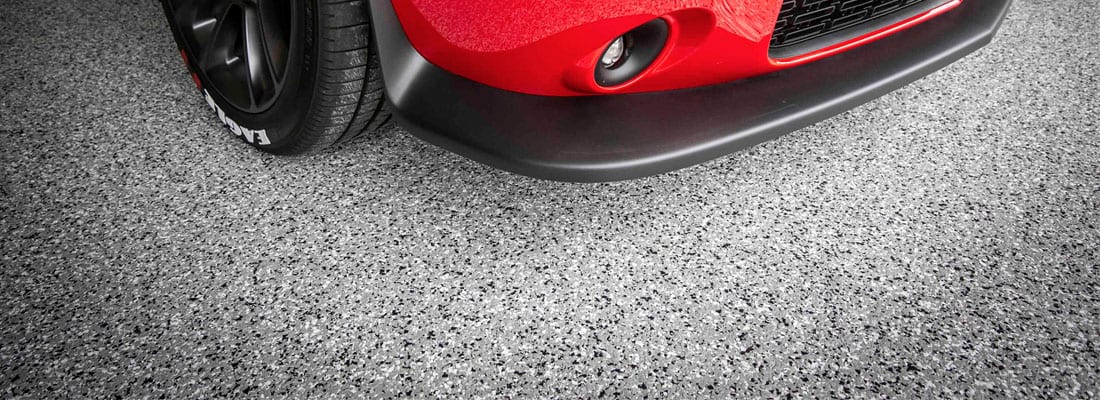
Applying an epoxy finish to your garage or shop floor may seem totally intimidating. But, in reality, it’s a job you can totally do yourself and will save you quite a bit of money. There are so many tools available to ensure your success. It’s a great idea to check out all the different online videos and tutorials that can walk you through the process step by step. Do a little homework and you can well be on your way to the beautiful garage floor you have dreamed of.
How to Prepare Your Garage Floor for Epoxy
Preparation is always key to a successful project. Here are the steps to follow to properly complete your garage floor epoxy.
1. Inspecting the floor
Some floors have a finish that isn’t conducive to epoxy application. If the floor has been painted or had a sealant put on it, it will need to be sanded or ground down to remove the coating. If you skip this step, the epoxy won’t adhere properly.
2. Check for moisture
Checking for moisture is another important step to take. Trapped moisture can affect the final finish. When inspecting the floor, you can see moisture through the areas of the surface that seem slightly damp. You also may see a white powder. This powder is made up of lime and mineral deposits that are left behind when the moisture evaporates.
If this white powder is only seen during the most humid times of the year you are fine. But, if the powder is visible year-round, the constant moisture will be a problem and the epoxy won’t adhere correctly. If you live in a hot, dry climate, this won’t be an issue you need to worry about.
3. Cleaning the garage floor
Cleaning your floor is the final step before application. Only start cleaning once you have made certain the floor is free of moisture and any other sealants. Be sure to remove any oils or residue on the floor. Patches of grease and oil won’t adhere to the epoxy so be aware of that. A good and final sweeping should be all that is required at this point.
4. Fixing flaws in the floor
The next step in the process is to fix any flaws in your floors such as gauges or dents. Avoid using any latex products for your repairs as latex shrinks over time and can leave behind evidence of the patchwork.
5. Profile the floor
Profiling your floor is the process of allowing the pores in the concrete to be revealed to provide a surface that is easy for the epoxy to stick to. There are two different ways that are commonly used to do this: grinding and acid etching. Most professionals prefer acid etching.
How to Apply Epoxy to Your Garage Floor
Make sure you have all the right tools on hand before you start the application. You need to be certain you have everything on hand. This will ensure your project will move forward smoothly and won’t be halted by emergency stops.
There are several different grades of epoxy you can choose from. We recommend the use of a commercial-grade product. This certain type of epoxy is very dense and is poured all at once, then rolled out with paint rollers until the entire surface is covered.
Cooperating Weather
High heat and humidity are the enemies of epoxy. Plan to start your project when the weather is amicable and cooperative. The ideal temperature to lay epoxy is between 55 and 90 degrees. The epoxy dries faster in the heat which means you will have to work faster and can make for a stressful time.
Just as with painting, you will want to take off any areas you don’t want the epoxy going. Be sure to remember to remove the tape approximately 30 minutes after the epoxy begins to harden. If you wait longer, the tape may be extremely difficult to remove with a clean edge.
Epoxy Prep
Make sure the epoxy is properly mixed before you apply it. It is always a smart idea to follow the manufacturer’s directions as closely as possible. If you will be mixing several epoxy kits, be sure to combine them into one batch for a more cohesive finished look.
To get the ideal surface look you want, you will more than likely have to apply several layers of epoxy. The first coat typically acts as a primer. From
the time you start pouring, plan on having roughly 40 minutes to get the epoxy rolled into place for a smooth finish.
How to Apply the Epoxy
We recommend that you apply the epoxy in a ribbon-like fashion. This will help you get a feel for how the concrete will grab the epoxy. Once the epoxy is poured and in place, you will want to work from the back corner of the garage, rolling in an outwards motion. Try to make sure your paint roller is evenly covered with epoxy to ensure the best coverage. Work fast and reapply epoxy to your roller as needed.
Use a chip brush for cutting in the corners. This will keep the epoxy from splashing onto other areas. A chip brush is also helpful in cleaning up spills or filling in spots you may have overlooked.
Backrolling
After the first coat has been rolled in one direction, it is time to roll the epoxy again at a perpendicular angle. This process, known as backrolling, will ensure the color and thickness of the product go on evenly and helps prevent air pockets from forming.
Be sure to wait 10-24 hours after applying the first coat, before you start with the second. Also, you’ll want to buff or sand the floor’s surface before laying the second coat so it will stick properly.
Applying the top coat
Be sure your first few layers are completely hardened and set before beginning to apply a top coat. You run the risk of leaving unwanted streaks behind if the epoxy isn’t fully dry. Once you’ve laid the top coat, give it 72 hours to cure before placing anything on it.
How long will my epoxy garage floor last?
The average life expectancy of an epoxy floor is 3 years. However, the more abuse it takes, the faster it will wear down and need another application. If time is taken to clean and maintain the flooring, the more life you will get out of it.
How to clean epoxy floors
Keeping epoxy floors clean is really quite simple. Sweep regularly to clear out any sand, small rocks, or dirt. When left behind they tend to leave scratches and dents in the glossy finish. We recommend mopping the surface regularly with only warm water. Soap has a tendency to leave a film
or residue that takes away from the shine. If tougher stains appear, you can use a gentle scrub brush. Once removed, a mix of ammonia and water can remove any lingering dirt or stains.
How much does epoxy garage flooring cost?
It is always important to know how much a project will cost before jumping in. For a single car garage in the Sacramento area, it will run you $750 on the lower end and $3000 on the high end. On average you can expect to pay $2 – $5 a square foot for materials and equipment. As a conservative
estimate, a professional installer will change the price to $3 – $12 a square foot.
A typical 2-car-garage with double the square footage will double the price as well. You can expect to pay closer to $1200 – $6000. This number can vary also depending on the type of epoxy and preferred application you choose to go with.
Conclusion
If you would like to learn more about epoxy garage flooring or would like to get a detailed estimate, give the experts at Epoxy Floor Pros a call. We have installed literally hundreds of epoxy floors. From textured to metallic, we offer a limitless variety of finishes to fit any personality. You can see the services we offer here.
Tags: diy epoxy, epoxy garage flooring, how to epoxy your garage floor

